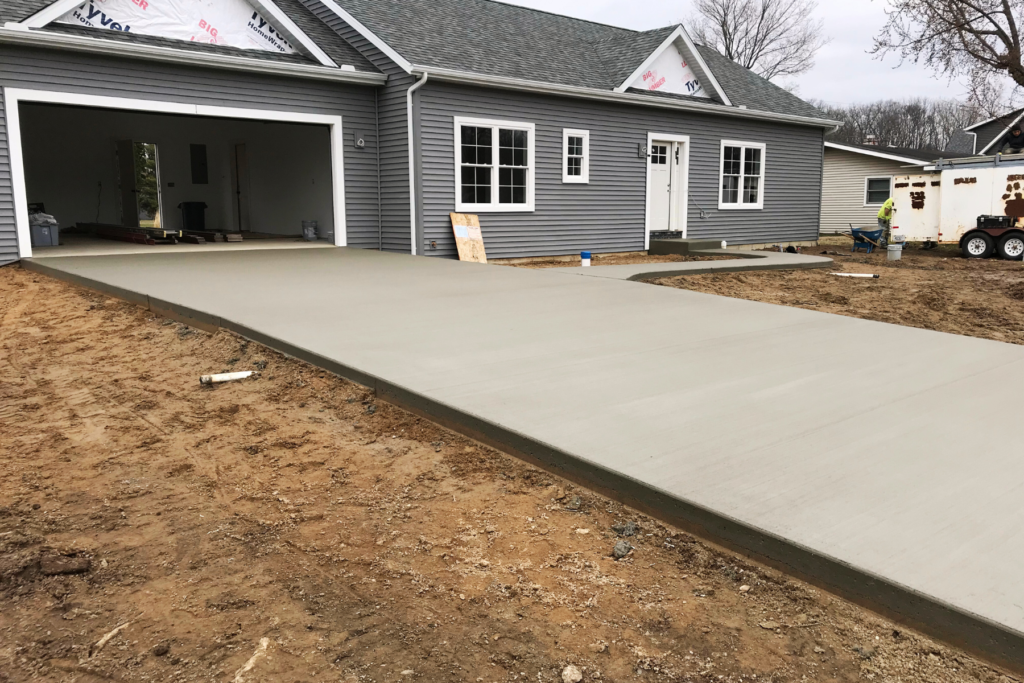what to know before we start
HOW TO CARE FOR YOUR CONCRETE
How to Care for Your Stamped Concrete
There are a few dos and don’ts to ensure your project continues to look fantastic for years to come!
The Dos:
- Clean your patio every three months.
- Reseal your concrete after the first year.
- Reseal your concrete every two years following the first year.
That’s it!
The Don’ts:
- Avoid direct contact with metal steel chairs. (They can leave rust spots.) Apply rubber stoppers at the bottom or keep a fresh coat of paint on your steel furniture to prevent rusting.
- Do not fill your lawn equipment with fuel on the patio. Fuel eats through the sealer and leaves stains.
- Use trays under potted plants to collect water. Fertilizer in the soil can leave a white haze on the concrete.
- Avoid leaving dirt and sand on the patio. It acts like sandpaper when walked on, causing the sealer to wear out sooner.
- Do not use acid cleaners or bleach to remove stains from your decorative surface. If cleaning the house with bleach, ensure the slab is wet and do not let cleaners dry on the slab.
How to Clean Your Patio
Supplies Needed:
- Dawn Dish Detergent
- Stiff Bristle Brush
- Five-Gallon Buckets
- Water Hose
- Your Favorite Spray Nozzle
Now that we have the supplies, let’s clean:
- Fill a five-gallon bucket with four gallons of water.
- Add two tablespoons of Dawn Dish Detergent. (Tip: Turn the bottle upside down and count a good ONE MISSISSIPPI.)
- Wet a 5′ x 5′ area with the hose.
- Dip your scrub brush in the bucket and work the detergent on the surface in a circular motion.
- Rinse this area off before moving to the next area.
- Repeat until the entire area is clean.
Tip: Be sure not to allow the detergent to dry on the surface. Rinse the area well and keep adjacent areas wet to ensure a good rinse and prevent the detergent from drying.
How to Seal Your Patio
Supplies Needed:
- Dawn Dish Detergent
- Stiff Bristle Brush
- Five-Gallon Buckets
- Water Hose
- Your Favorite Spray Nozzle
- Pressure Washer (for hard stains and mildew)
- Plastic Pump-up Sprayer
- J-18 Concrete Cure and Seal / Sealant
Now that we have the supplies, let’s seal:
- Follow the steps to clean your patio. (You may need a pressure washer to remove additional stains and mildew growth.)
- Ensure the patio is completely dry of moisture. (No puddles.) Take a break, have lunch, enjoy your day, and plan to seal it a couple of hours before dusk.
- Fill your sprayer with J18 Sealer. (A little goes a long way!) Generally, it covers 250-300 sq/ft per gallon.
- Spray your sealer in a circular motion 12″ above the slab. Ensure you do not puddle the sealant. It needs one coat of a nice mist. This sealer goes on white and dries clear.
- Stay off the slab for 12 hours.
Tip: Keep a rag handy to absorb areas that are accidentally puddled. If the product goes on too thick, it will stay milky white.

Additional Information on Caring for Concrete
Taking proper care of your concrete ensures it remains durable and attractive for years to come. Here are some more tips and guidelines to help you maintain your concrete surfaces effectively:
General Maintenance
Regular Cleaning:
- Sweep your concrete surfaces regularly to remove dirt, leaves, and debris.
- For a deeper clean, use a mild detergent and water. Avoid harsh chemicals that can damage the surface.
Stain Prevention:
- Quickly clean spills of oil, grease, and other substances to prevent stains.
- Use mats or trays under barbecues, vehicles, and plants to catch drips and spills.
Sealing:
- Apply a quality concrete sealer every 1-2 years to protect the surface from moisture, chemicals, and wear.
- Ensure the concrete is thoroughly cleaned and completely dry before sealing.
Winter Care
De-icing:
- Avoid using de-icing salts on your concrete as they can cause surface damage. Instead, use sand or cat litter for traction.
- Shovel snow promptly to prevent ice buildup.
Freeze-Thaw Cycles:
- Be mindful of water pooling on your concrete during winter. Freeze-thaw cycles can cause cracks and damage.
- Ensure proper drainage to minimize water exposure.
Crack Repair
Small Cracks:
- Fill small cracks with a concrete caulk to prevent them from growing larger. This helps maintain the structural integrity of the surface.
Larger Cracks:
- For cracks wider than 1/4 inch, consider using a concrete patching compound or hiring a professional for repair.
Heavy Load
Weight Limitations:
- Avoid placing extremely heavy objects, like large vehicles or machinery, on your concrete surfaces, especially in the first year while it cures.
- Use plywood or other protective materials if heavy equipment must be used on the concrete.
Landscaping Considerations:
Watering:
- Ensure proper watering of adjacent lawns and gardens. Overwatering can lead to water seeping into the concrete and causing damage.
- Use soaker hoses or drip irrigation to minimize water runoff onto concrete surfaces.
Tree Roots:
- Be cautious of tree roots near concrete slabs. Roots can grow under the concrete and cause lifting or cracking.
- Consider root barriers or consult a professional if you have large trees near your concrete.
Avoiding Damage
Protective Measures:
- Use furniture pads or rubber feet on metal and wooden furniture to prevent scratches and rust stains.
- Avoid dragging heavy objects across the concrete surface to prevent gouges and scratches.
Chemical Exposure:
- Limit exposure to harsh chemicals such as fertilizers, pesticides, and pool chemicals. These can cause discoloration and surface damage.
- Rinse off any chemical spills immediately with plenty of water.
Professional Maintenance:
Periodic Inspections:
- Schedule regular inspections with a concrete professional to assess the condition of your concrete surfaces.
- Address any issues promptly to prevent further damage and maintain the longevity of the concrete.
By following these care tips and maintaining your concrete surfaces regularly, you can ensure that they remain strong, attractive, and functional for many years. If you have any specific questions or need professional advice, don’t hesitate to contact us at Crown Concrete. We’re here to help!


